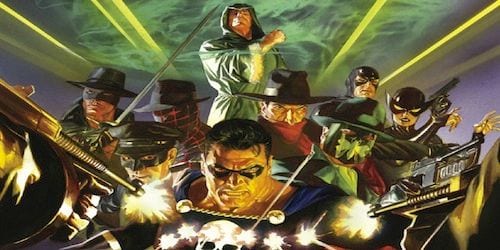
Dynamite’s Masks is a beast of a series. Crossovers are a time-honored tradition of the comicbook industry, and in the modern age of unlikely team-ups and more cohesive universes, Dynamite decided it was high time for it’s classic heroes to meet each other. For writer Chris Roberson, this meant crafting a meeting that had significance beyond simply dismantling another organized crime ring or hunting down another serial killer. Featuring The Shadow, Green Hornet & Kato, The Spider, and Zorro in the same series meant bringing something monumental to the table that could feasibly make these heroes work together. So what’s a greater threat to the state than the some mafia family, crooked businessmen, or group of bank robbers? Why, the state itself.
Fascism is an excellent setting for a pulp action series such as this because it uproots the status quo our heroes have depended upon their entire careers. These heroes rely on their relationships with local authorities and the knowledge that the justice they serve is righteous. The nefarious Justice Party mirrors the worst characteristics of our real-life political machines that controlled major cities during the turn of the century: fascist rule that casts a submissive pall over the population, allowing the rich to subjugate the poor and weak.
The Justice Party’s Gestapo-like shock troopers convey this message of total control with their iron grip on the city’s population through fear tactics. People are asked to pay random taxes and are jailed if unable to pay on the spot, harsher restrictions are levied daily in the name of ‘security’ and ‘safety’, and the entire city lives in constant paranoid fear of it’s own government’s arbitrary ruthlessness. It is with nowhere else to turn that the protagonists of Masks must turn to one another. With corruption widespread at seemingly every level of the state government, no one of them could take on the Justice Party alone.
But a greater question remains: how exactly will these heroes take down the Justice Party at all? In the past, each of them have worked with the law on their side (for the most part), often through relationships with key individuals. Yet now, seemingly overnight, that fact has changed leaving all of them in desperate need of new ideas for how to battle something they’ve never faced before. At its core, Masks #3 is focused on understanding the current situation and how it can be fixed. Roberson’s inclusion of new, unnamed vigilantes is an excellent addition to Masks, one that gives it a more cohesive feel than if just the Fab Five were being used.
On an editorial level, Roberson asks the question, “If there are at least these five men with masks, why couldn’t there be more?” The Justice Party isn’t like the mafia, their actions aren’t hidden in the shadows, and their oppression is felt on a daily basis. It’s no wonder more individuals are coming out of the woodwork to fight against the injustice and make a change.
Though there are still a lot of fights, Masks is a story primarily about the war of ideals. These pulp heroes exist in an era that was rife with political corruption and governmental propaganda. The way citizens are detained for the smallest of suspicions isn’t dissimilar from the practices of McCarthyism, while the legal precedent for this new world order is being freshly inked as the Justice Party gains more and more influence. This political machine is such a formidable adversary because we don’t really know anything about its real goals. Sure, the party controls most the New York state government, but to what ends? We don’t know if there’s one mastermind behind the Justice Party, or if it’s a group of people. Beyond detaining large numbers of normally innocent civilians, there doesn’t seem to be a concrete reason for the totalitarian steps taken to ensure complete control, either.
My only real complaint about an otherwise fantastic issue is that it falls prey to ‘filler issue syndrome’, wherein the middle issues of a limited series are decompressed more than the beginning and ending issues to draw readers into the story at a certain pace. While multiple read-throughs yield more understanding about which pieces are moving where, most readers don’t incessantly analyze their weekly books, so many of the nuances and subtle plot nods Roberson plants could be lost on the casual reader looking for a more straightforward pulp adventure.
The final pages of Masks #3 brings some insight to the Justice Party’s intentions that raises a whole new set of questions for the series going forward because the Party’s actions could have, up to now, been chalked up to pure financial gain. The end of Masks #3 confirms that this corruption is a lot more complicated than any of our heroes could have anticipated. The Justice Party is not something than can be punched, or tasered, or shot—this is an enemy that defies all previous conventions and is eating society from within, and there are still five issues left.
